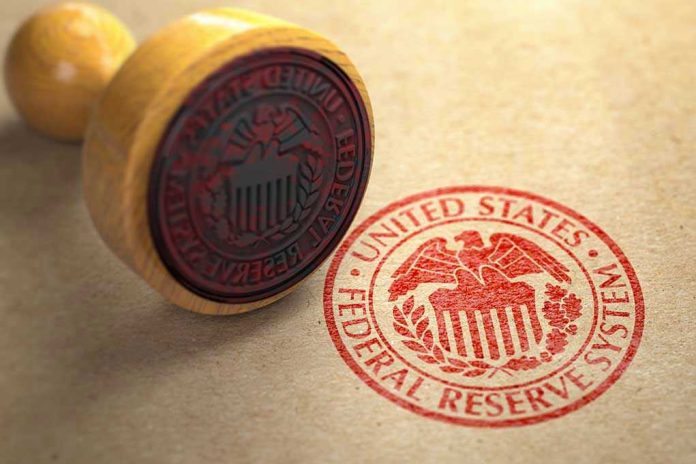
The Federal Reserve is sounding alarm bells about inflation spiraling in the wrong direction while trade policy threatens to pour gasoline on an already smoldering economic fire.
Story Snapshot
- Fed officials publicly warn that inflation trends are deteriorating despite previous rate cuts
- New tariff policies risk pushing consumer prices significantly higher across multiple sectors
- The central bank faces an impossible choice between supporting jobs and controlling runaway prices
- Markets expect more rate cuts even as inflation remains stubbornly above the Fed’s 2% target
The Fed’s Inflation Nightmare Returns
Federal Reserve Chair Jerome Powell delivered a stark assessment that should concern every American family: inflation is moving in the wrong direction. After cutting rates by 0.25% in July 2025 to support a weakening labor market, Fed officials now confront the uncomfortable reality that their monetary medicine may be making the inflation disease worse. The central bank’s 2% inflation target remains elusive, with recent data showing persistent price pressures across the economy.
Bill Merz from U.S. Bank Asset Management points out that while labor market weakness drives Fed decisions, consumer spending remains surprisingly solid. This economic contradiction creates a dangerous dynamic where rate cuts intended to boost employment actually fuel more consumer demand and higher prices. The Fed finds itself trapped between two competing mandates with no clear path forward.
Tariffs: The Inflation Accelerant Nobody Wants to Discuss
Powell acknowledged that tariff pass-through to consumers has been “pretty small” historically, but companies now signal their intention to pass along significantly more cost increases. This represents a fundamental shift in corporate pricing strategy that threatens to unleash a new wave of inflation. Business surveys consistently show rising input costs, with tariff-affected sectors reporting the steepest price pressures in recent memory.
The timing couldn’t be worse for American families already struggling with elevated prices. Manufacturing and retail sectors, most directly impacted by tariff policies, are preparing consumers for substantial price increases. These aren’t temporary adjustments but structural changes that could persist for years. The Fed’s ability to control inflation through interest rates becomes severely limited when government trade policy actively works against price stability.
An Impossible Economic Balancing Act
The October 28-29 Fed meeting looms large as markets expect another rate cut despite mounting inflation concerns. This expectation reveals a dangerous disconnect between market optimism and economic reality. Investors seem to believe the Fed can simultaneously support employment and control inflation, but recent history suggests otherwise. The central bank’s data-driven approach offers little comfort when the data points in contradictory directions.
Economic crosscurrents have placed the Fed in an unprecedented position where traditional monetary policy tools appear inadequate. Rate cuts that historically supported employment now risk creating asset bubbles and consumer price inflation. Meanwhile, the threat of stagflation – high inflation combined with weak growth – grows more real each month. American families face the prospect of higher prices and uncertain job security, a combination that has historically proven politically explosive.
Sources:
U.S. Bank Asset Management Group









